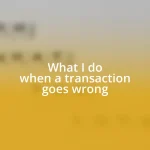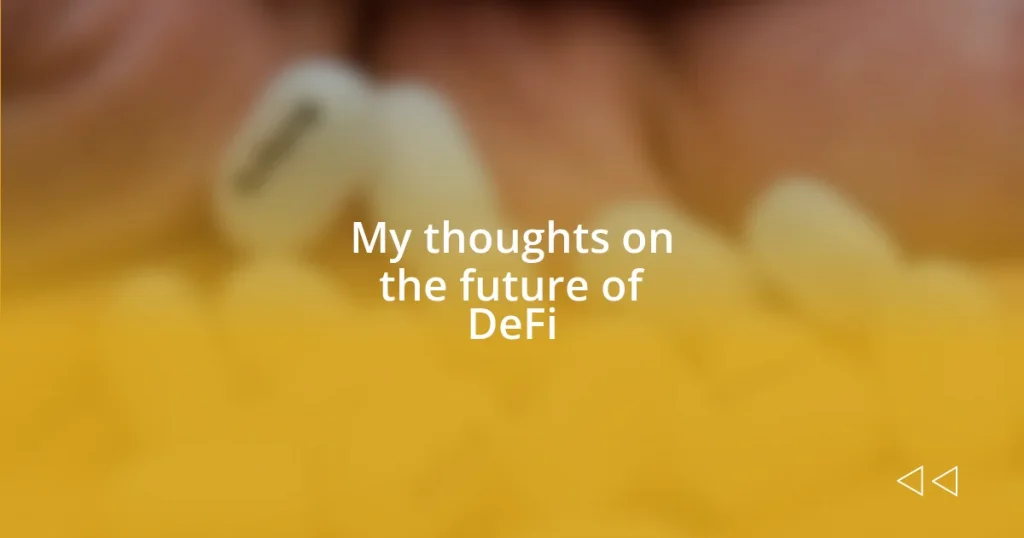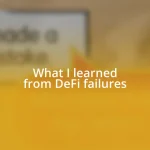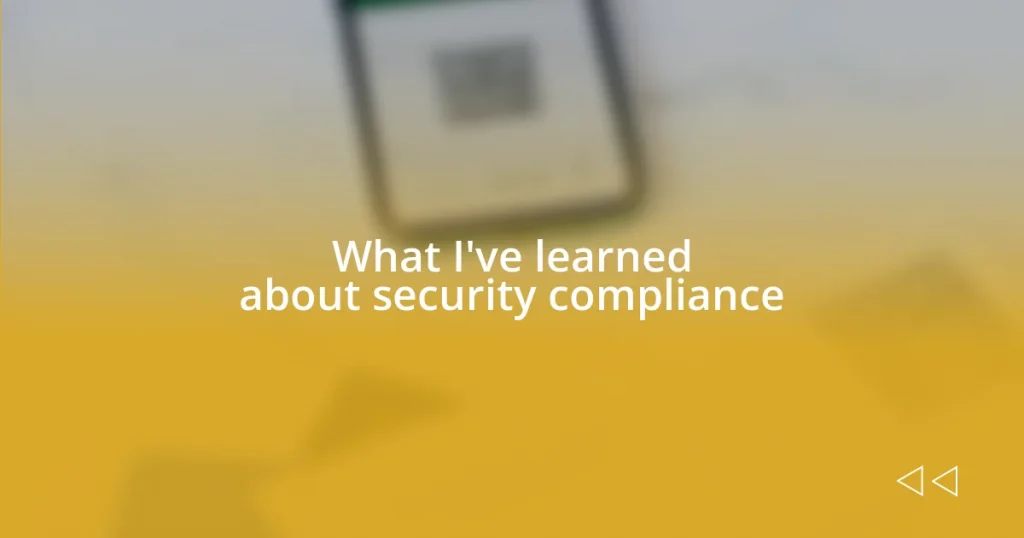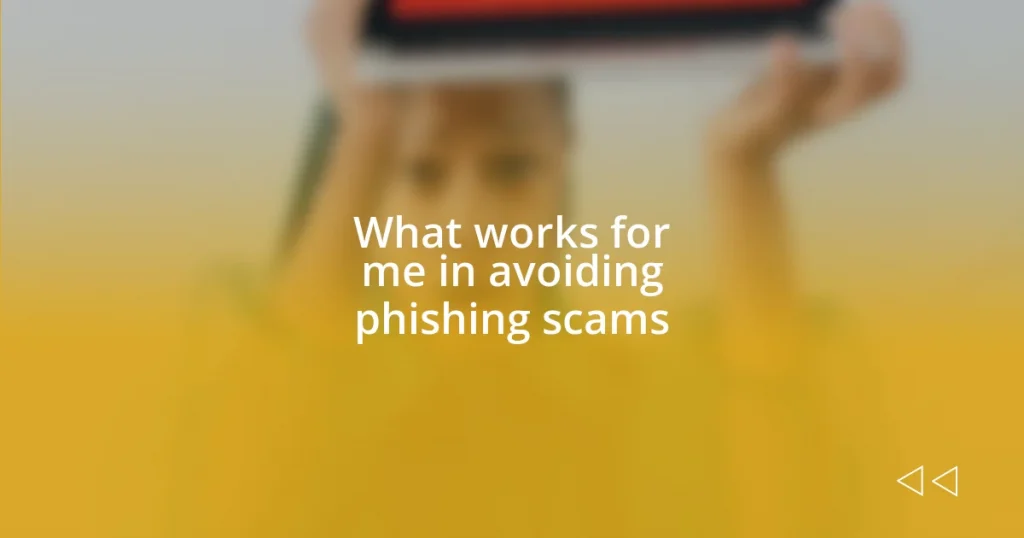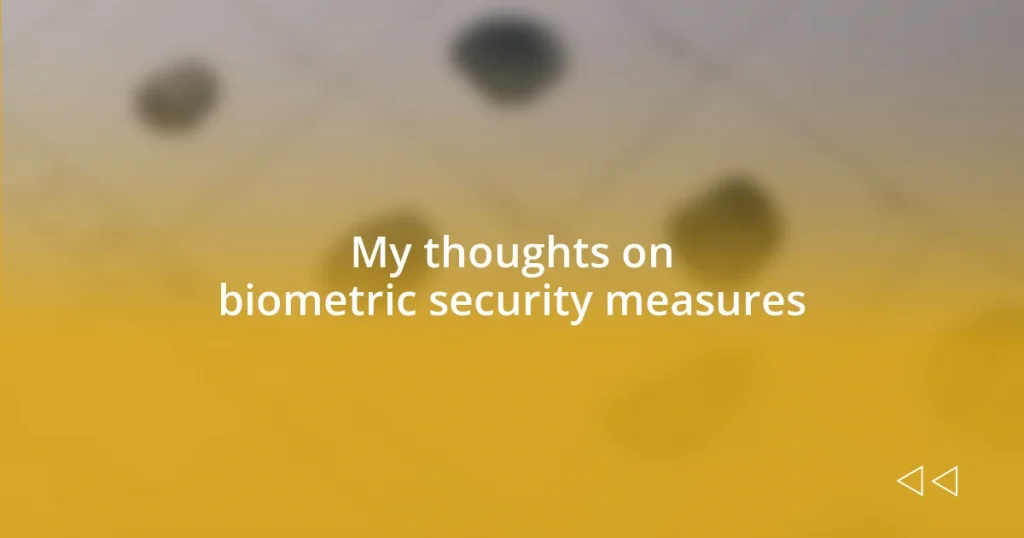Key takeaways:
- The rise of yield farming and decentralized exchanges (DEXs) is revolutionizing trading by enhancing accessibility and maximizing earnings for users.
- Key innovations, such as automated market makers (AMMs) and multi-chain interoperability, are shaping the future of DeFi, empowering users and enhancing market participation.
- Major challenges, including regulatory uncertainty and the complexity of DeFi products, must be addressed to foster wider user adoption and protect investors.
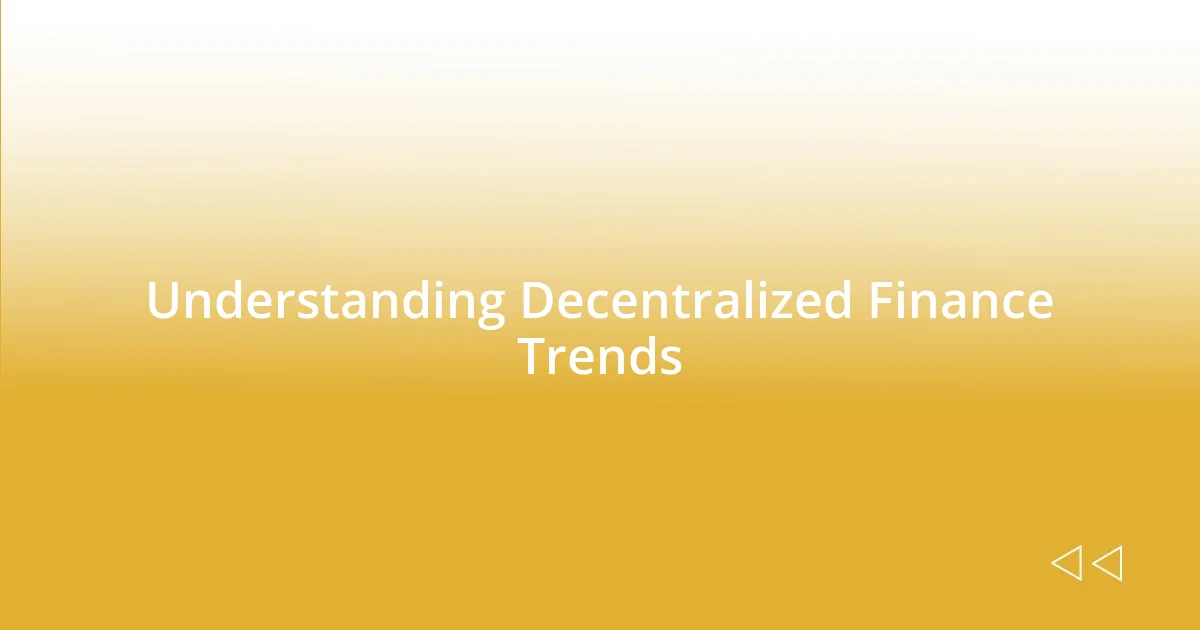
Understanding Decentralized Finance Trends
One of the most striking trends I’ve observed in decentralized finance is the rise of yield farming. When I first dipped my toes into this space, I was amazed at the potential returns offered by various protocols. It’s not just about staking assets anymore; it’s a dynamic landscape where liquidity providers can maximize their earnings through strategies that were once exclusive to traditional finance. Isn’t it fascinating how DeFi has opened up these opportunities to everyone, regardless of their financial background?
As I reflect on the growth of decentralized exchanges (DEXs), I can’t help but feel a sense of excitement. These platforms are revolutionizing how we trade assets, with lower fees and greater accessibility. I remember my first experience swapping tokens on a DEX—it was a game-changer for me. I found myself questioning the need for intermediaries in trading altogether. This shift towards trustless environments truly empowers users and fosters innovation. How many traditional finance elements do you think will still be relevant in the DeFi era?
Finally, the integration of NFTs into DeFi is a trend that speaks volumes about the future. When I first encountered NFT collaterals, I realized the creative possibilities that lay ahead. It’s like watching a new form of digital ownership evolve in real-time. The emotional connection we have with these assets adds a layer of value that traditional finance often overlooks. Have you thought about how this fusion could reshape our understanding of collateral and valuation in lending? It certainly kept me pondering long after I first engaged with it.

Key Innovations Shaping DeFi Future
As I look ahead, I see the emergence of automated market makers (AMMs) significantly altering the landscape of DeFi. The first time I interacted with an AMM, it struck me how they eliminate the need for order books, allowing users to trade directly against a liquidity pool. This not only streamlines the trading process but also creates a more democratic form of market access, where everyone can participate. Isn’t it empowering to think that you can contribute to liquidity and earn a share of the fees?
Moreover, multi-chain interoperability is catching my attention. I recall the moment I realized how different blockchains could communicate seamlessly, opening up a world of opportunities. This innovation ensures that users can access various DeFi services across platforms, maximizing their investment potential. It’s exciting to envision a future where barriers between blockchains dissolve, allowing for a more cohesive and efficient DeFi ecosystem.
Lastly, I can’t overlook the role of decentralized identity solutions shaping our future interactions in DeFi. The first time I encountered blockchain-based ID systems, I was struck by their potential to solve issues around data privacy and security. This innovation allows users to verify their identities without compromising sensitive information. It’s a game changer, ensuring that we can engage safely and freely in financial activities without the constant fear of identity theft. How reassuring is it to know that our identities could be securely managed on the blockchain?
| Innovation | Description |
|---|---|
| Automated Market Makers (AMMs) | Facilitate direct trading from liquidity pools without order books, enabling more accessible trading environments. |
| Multi-chain Interoperability | Allow different blockchains to communicate, enhancing user access to diverse DeFi services and increasing investment options. |
| Decentralized Identity Solutions | Provide secure verification of user identities, enhancing data privacy while engaging in DeFi activities. |
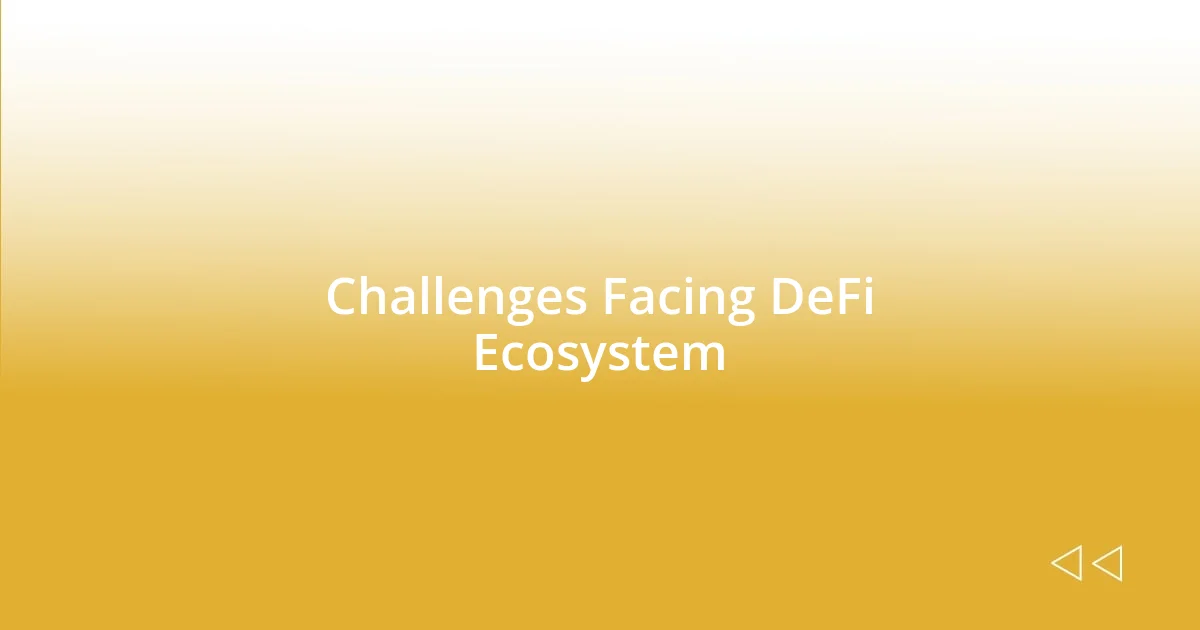
Challenges Facing DeFi Ecosystem
It’s hard to ignore the significant challenges that the decentralized finance (DeFi) ecosystem is currently grappling with. One of the most pressing issues I encounter online is the regulatory uncertainty surrounding DeFi. I remember my feeling of apprehension when I first learned about the potential for government oversight of decentralized platforms. It’s a double-edged sword; while regulation could bring legitimacy to the space, it might stifle the creativity and innovation that make DeFi so compelling.
Certainly, the challenges include:
- Regulatory Uncertainty: Governments are still formulating their stance on DeFi, which can create fear and hesitance among users and developers alike.
- Smart Contract Vulnerabilities: No one wants to be in the position where they lose funds due to bugs or exploits in a contract.
- User Education: Many potential users are still confused about how DeFi works, making it hard for them to participate confidently.
- Scalability Issues: As more users flock to DeFi protocols, the networks often get congested, leading to higher transaction costs and slower processing times.
Another challenge that frequently crosses my mind is the risk of market manipulation and the lack of investor protections. A couple of weeks ago, I stumbled upon a startling article identifying flash loan attacks that exploited weaknesses in liquidity pools. I felt a mix of disbelief and concern; it’s alarming to think that such mechanisms can be misused, especially since many participants enter this ecosystem with high hopes and little understanding of the risks involved.
This all brings to light even more challenges:
- Market Manipulation: With less oversight, unscrupulous actors can exploit vulnerabilities, which can lead to volatile price swings.
- Lack of Investor Protections: There are minimal safeguards for users, raising the stakes for those not aware of the risks.
- Liquidity Risks: Variables like market sentiment can quickly drain liquidity, making it hard for users to execute trades without significant losses.
- Complexity of Products: The decentralized finance space is saturated with innovative products that can overwhelm users unfamiliar with the technology.
As someone who has navigated these waters, it’s a mixed bag of excitement and trepidation for the future of DeFi. The innovations are fantastic, but the potential pitfalls can be disheartening.
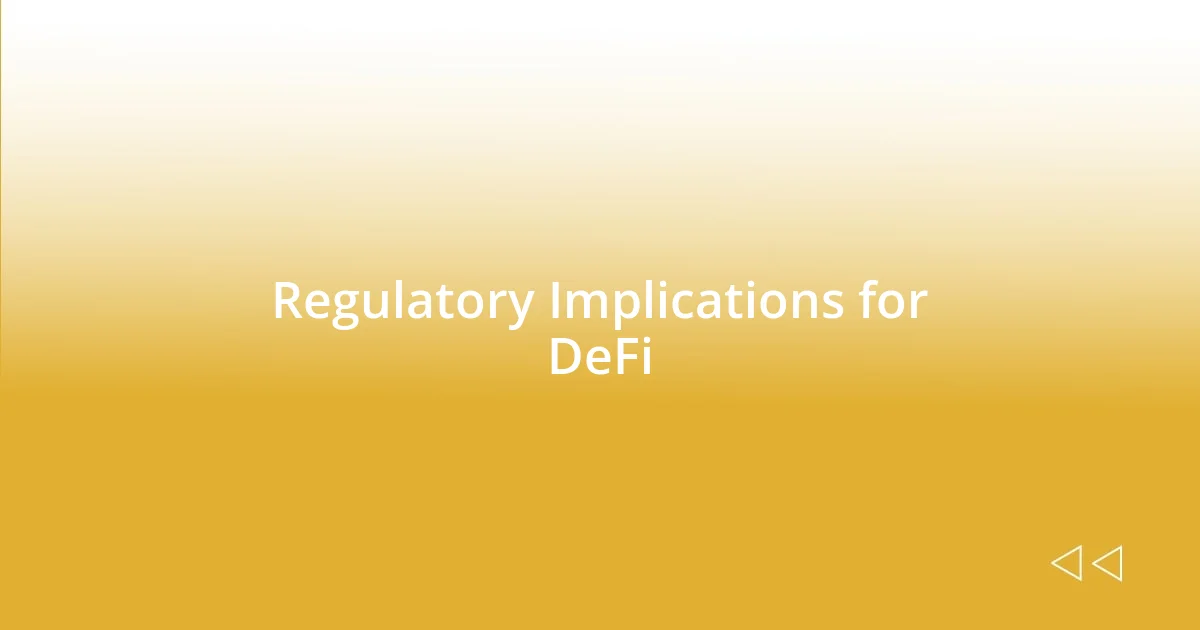
Regulatory Implications for DeFi
The regulatory implications for DeFi are fascinating and, frankly, a bit daunting. I recall sitting in a webinar where experts debated whether regulators could effectively oversee truly decentralized platforms. It reminded me of trying to herd cats—challenging but so necessary to ensure a safe environment. The thought of regulations is sometimes comforting, but it also makes me wonder: how might this impact innovation that thrives on freedom?
It’s essential to consider that as regulations evolve, they may incentivize more traditional financial institutions to integrate with DeFi. I remember my surprise during a discussion about how banks could eventually embrace decentralized finance as a means to streamline their operations. This could potentially enhance compliance, but I can’t help but feel a twinge of concern. Will this shift dilute the very essence of what makes DeFi unique and attractive to its community?
Who is at the forefront of these regulatory discussions? It’s often policymakers who may lack a full understanding of DeFi’s complexities. I once shared a conversation with a friend who is a financial analyst; he expressed concern that regulations might overlook the nuanced mechanisms of smart contracts. How can we ensure that those in power are not only aware of these innovations but also competent enough to shape their future? It’s a question we all should ponder as we navigate this uncertain landscape.
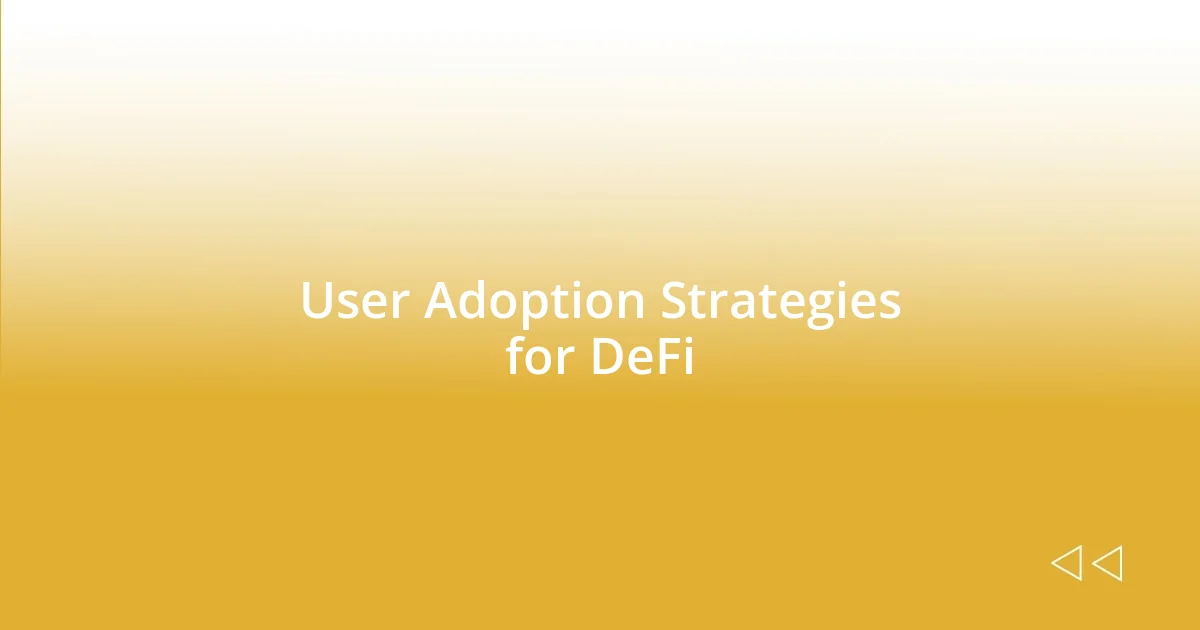
User Adoption Strategies for DeFi
User adoption in the DeFi space hinges on effective education and outreach. I vividly remember when I first ventured into DeFi; it felt overwhelming trying to grasp concepts like liquidity pools and yield farming. I’ve found that tailored educational programs—think workshops and online courses—can bridge this knowledge gap. These opportunities allow newcomers to build confidence and engage with the community, making the experience less intimidating.
A simple yet effective strategy is to create user-friendly interfaces that demystify DeFi protocols. I often hear friends express their frustration when they encounter complex dashboards. It’s crucial that platforms prioritize intuitive design to lower the barrier of entry for new users. By simplifying processes, we can encourage more people to dip their toes into this exciting ecosystem rather than shy away from potential confusion or fear.
Community-building is another cornerstone of enhancing user adoption. I recall attending a local meetup aimed at discussing DeFi trends; it struck me how invigorating it was to connect with others who shared similar interests. Fostering a supportive community not only helps users feel valued but also promotes open discussions around experiences, tips, and best practices, creating an inviting environment for both enthusiasts and novices alike. Wouldn’t you agree that a sense of belonging can turn hesitant individuals into active participants?

Future Investment Opportunities in DeFi
Future Investment Opportunities in DeFi
As I think about the future of investment opportunities in DeFi, I can’t help but feel excited about the potential for innovative projects. For instance, I came across a promising concept where decentralized autonomous organizations (DAOs) might revolutionize venture capital by pooling funds directly from the community. Just imagining the possibility of anyone, regardless of their financial background, being able to support and invest in groundbreaking projects makes me hopeful for inclusivity in finance.
Another area I find intriguing is the rise of yield aggregation platforms. I recall my own experiments in yield farming—while it was a bit of a roller coaster ride, the returns were quite thrilling. It’s fascinating to think that as these platforms become more sophisticated, they could streamline investments and optimize returns for even novice investors. Will this lead to a more democratized financial landscape?
Lastly, I see immense potential in the evolution of insurance protocols within DeFi. During a discussion with a friend about risk management, I realized how a well-structured decentralized insurance model could alleviate many concerns investors face. It raises the question: what if we could protect our digital assets as easily as we insure our homes? This could transform how people perceive and engage with DeFi, opening up a world of opportunities that encourage more robust participation.

Conclusion and Personal Insights
As I reflect on the journey DeFi has taken so far, I can’t help but feel a sense of optimism. When I first dove into decentralized finance, I was met with skepticism from friends who couldn’t see past the volatility and risks. However, I believe that by promoting transparency and education, we can shift that perspective, making DeFi not just an option for tech enthusiasts but a viable financial alternative for everyone.
In my experience, the emotional journey of embracing DeFi is a testament to its transformative potential. I remember sharing my first successful yield farming experience with my family, their expressions shifting from confusion to curiosity. It’s moments like these that remind me of the power of community and shared knowledge in demystifying complex financial concepts. Doesn’t it feel like together we can build a more inclusive financial future?
Looking ahead, I see an exciting divergence in how we interact with financial systems. The thought of smart contracts autonomously executing our wishes—like a friendly financial advisor that never sleeps—gives me chills. It’s a brave new world where autonomy and security can coexist, making me wonder: could this be the dawn of a truly democratized finance? The potential for personalization and empowerment in DeFi feels limitless, and I can’t wait to see how it all unfolds.





